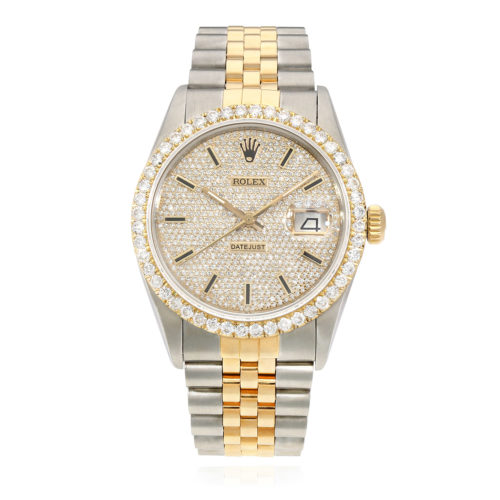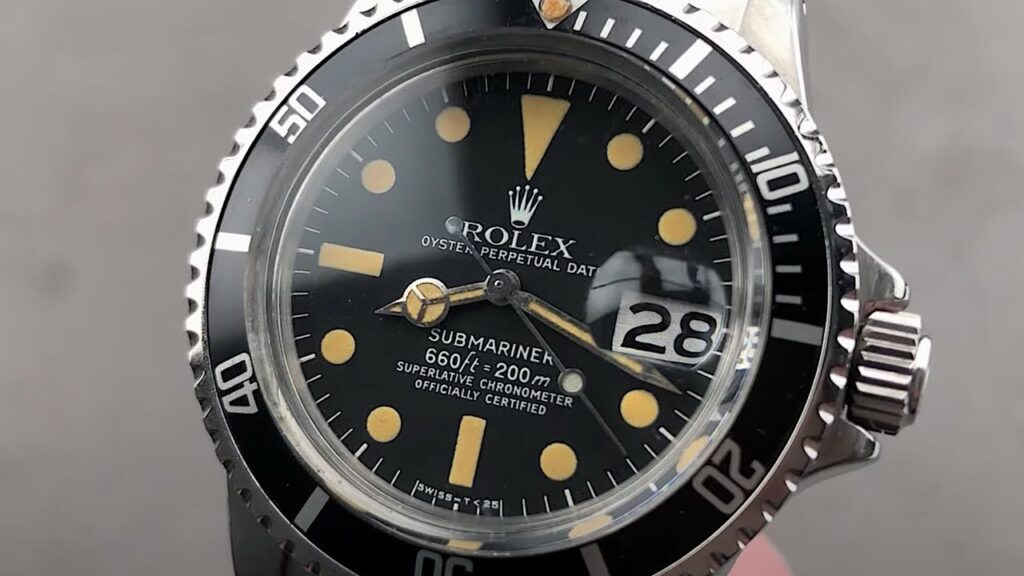
The Rolex Oyster Perpetual Submariner Date 1680 is a highly sought-after timepiece that combines timeless design with exceptional functionality. This watch features a 40mm stainless steel case and a black dial, perfectly complemented by a stainless steel Oyster bracelet. With features including hours, minutes, seconds, and date, this Rolex watch is both stylish and practical. Measuring 13.9mm in thickness and 47.6mm from lug-to-lug, it is the perfect size for those seeking a versatile timepiece. For a comprehensive review of the Rolex Oyster Perpetual Submariner Date 1680, visit our website for the latest pre-owned luxury watch arrivals.
The Rolex Oyster Perpetual Submariner Date 1680 is a remarkable watch that boasts an impressive array of features. With its 40mm stainless steel casing, black dial, and stainless steel Oyster bracelet, it exudes elegance and sophistication. In addition to its eye-catching design, this watch also offers practicality with functions such as hours, minutes, seconds, and date. Measuring 13.9mm in thickness and 47.6mm from lug-to-lug, it is both sleek and comfortable to wear. For those interested in delving deeper into the intricacies of this timepiece, Tim Mosso’s review provides a comprehensive overview. Visit our website for the latest pre-owned luxury watch arrivals and discover the industry-leading value of previously loved timepieces.
Specifications
Case
The case of a watch is one of the most important aspects when it comes to its design and functionality. It serves as the protective covering for the inner workings of the watch, ensuring that they are safe from external elements such as water, dust, and shocks. When considering a watch, it is crucial to pay attention to the material and construction of the case.
Bracelet
The bracelet of a watch is the band that attaches the timepiece to your wrist. It plays a significant role in the overall design and comfort of the watch. You should consider the material, design, and clasp mechanism of the bracelet when evaluating a timepiece.
Movement
The movement of a watch refers to the mechanism that powers its functions. There are different types of movement, including mechanical, automatic, and quartz. The movement determines the accuracy, reliability, and maintenance requirements of the watch.
Water Resistance
Water resistance is an essential feature to consider if you plan to wear the watch in wet or aquatic environments. The level of water resistance is measured in meters or atmospheres. It is important to choose a watch with an appropriate water resistance rating to ensure its longevity and functionality.
Design
Dial
The dial of a watch is the face or the front part of the timepiece. It showcases the hour markers, hands, and other functions such as date windows and chronograph sub-dials. The dial design includes factors like color, style, and legibility.
Bezel
The bezel is a ring that surrounds the watch’s dial and is usually rotatable. It serves multiple functions, including measuring elapsed time, calculating dive times, or acting as a decorative element. The bezel can be unidirectional or bidirectional, depending on the watch’s intended purpose.
Cyclops Eye Magnifier
Some watches feature a magnifying lens, known as the Cyclops Eye Magnifier, which is positioned above the date window. It enlarges the date display, improving readability. This feature can be both functional and aesthetically pleasing.
Size and Thickness
The size and thickness of a watch are crucial factors to consider, as they determine how comfortable and proportional the timepiece will be on your wrist. It is essential to choose a watch that suits your wrist size and personal style preference.
Vintage Look and Feel
Many watch enthusiasts appreciate the charm and elegance of vintage-inspired designs. A watch with a vintage look and feel can add a touch of nostalgia and sophistication to your overall style. It often features retro-inspired elements, such as domed crystals, aged lume, and classic dial designs.
Bracelet Design
The design of the bracelet can significantly impact the overall aesthetics and comfort of the watch. Depending on the watch’s style and intended use, you can choose from different bracelet designs, including metal bracelets, leather straps, and rubber bands.

Features
Hours, Minutes, Seconds
The primary function of a watch is to accurately display the time. Most watches feature hour, minute, and second hands, allowing you to keep track of time with precision. The readability and legibility of the hands are important factors to consider when evaluating a watch’s functionality.
Date Functionality
The date function is a common feature found in many watches. It displays the current date in a designated window on the dial. The date windows can come in various shapes and positions, and some watches even include other functions, such as day and month displays.
Hacking Seconds
Hacking seconds is a feature that allows you to stop the second hand when adjusting the time. This feature enables precise time-setting, as the second hand remains steady while you synchronize the watch with another timekeeping device.
Automatic Winding
Automatic winding, also known as self-winding, is a feature that uses the natural motion of the wearer’s wrist to wind the watch’s mainspring. This eliminates the need for manual winding and ensures that the watch remains powered as long as it is worn regularly.
Power Reserve
The power reserve refers to the amount of time a watch can continue running without needing to be wound or worn. It is an important consideration for individuals who may not wear their watch every day or for those who own multiple timepieces. A longer power reserve ensures that the watch will continue to function even after being left idle for a certain period.
COSC Certification
The COSC (Contrôle Officiel Suisse des Chronomètres) certification is a prestigious recognition given to watches that demonstrate exceptional accuracy and precision. Watches with COSC certification undergo rigorous testing and meet strict standards set by the Swiss Official Chronometer Testing Institute.
Condition
Case
The condition of a watch’s case reflects its overall appearance and durability. Scratches, dents, or damages to the case can affect the aesthetic appeal and functionality of the timepiece. When purchasing a watch, it is important to inspect the case for any signs of wear or damage.
Bezel
The bezel is another component of a watch that can show signs of wear or damage. As a rotating part, it is more prone to scratches or misalignment. A well-maintained and intact bezel contributes to the overall functionality and attractiveness of the watch.
Plexiglass
Plexiglass, also known as acrylic crystal, is a common material used in watch crystals. It offers good scratch resistance and is lightweight. However, due to its relatively soft nature, plexiglass is more susceptible to scratches and may require more frequent maintenance and care.
Dial
The condition of the dial is crucial for the legibility and overall appearance of the watch. Any discoloration, fading of the hour markers or hands, or damage to the dial surface can significantly affect the overall aesthetic appeal and value of the timepiece.
Performance
Accuracy
The accuracy of a watch is an important factor to consider, especially if you rely on it for precise timekeeping. The accuracy is determined by the movement type and the watch’s ability to maintain consistent timekeeping over a certain period. Look for watches that have excellent accuracy ratings or are certified by official chronometer testing institutes.
Winding
The winding mechanism of a watch affects how you keep the watch running. Manual winding requires regular winding by turning the crown, while automatic winding uses the natural motion of your wrist. Consider your personal preferences and lifestyle when choosing between manual and automatic winding.
Power Reserve
The power reserve of a watch plays a significant role in its performance and convenience. A longer power reserve allows the watch to run for an extended period without winding or wearing. However, it is also essential to balance the power reserve with the watch’s size and weight.
Versatility
Daily Wearability
A versatile watch is one that can be worn comfortably in various daily activities and settings. It should have a design that complements different outfits and occasions. A watch with a simple and timeless design, adaptable strap options, and appropriate size can enhance its daily wearability.
Diving Capabilities
If you are looking for a watch specifically for diving or water-related activities, it is crucial to consider its diving capabilities. Look for watches that offer adequate water resistance, a unidirectional rotating bezel for measuring elapsed time, and luminous hands and markers for enhanced visibility underwater.
Timing Function
Some watches offer additional features for measuring and tracking time beyond basic hours, minutes, and seconds. These can include chronograph functions, tachymeters, or world time zones. If you require specific timing functions, it is important to choose a watch that offers the desired features.
Price
Budget-Friendly
When considering a new timepiece, it is important to set a budget and find a watch that offers value within that price range. There are many high-quality watches available at various price points, ensuring that you can find a timepiece that meets your needs without breaking the bank.
Pre-Owned Pricing
Pre-owned watches can offer excellent value for money, allowing you to own luxury or high-end timepieces at a more affordable price. However, it is essential to carefully assess the condition, authenticity, and reputation of the seller when purchasing pre-owned watches.
Value for Money
Value for money is a crucial aspect when purchasing a watch. It is important to consider the overall quality, features, durability, and brand reputation in relation to the price. A watch that offers a good balance between these factors can be considered a solid investment.
Conclusion
When choosing a watch, it is essential to consider various specifications, design elements, features, condition, and performance. Whether you prioritize accuracy, style, or functionality, finding the perfect watch requires careful evaluation and consideration of your personal preferences and needs. By understanding the key factors outlined in this article, you can make an informed decision and find a timepiece that meets your requirements and brings you years of enjoyment.


















